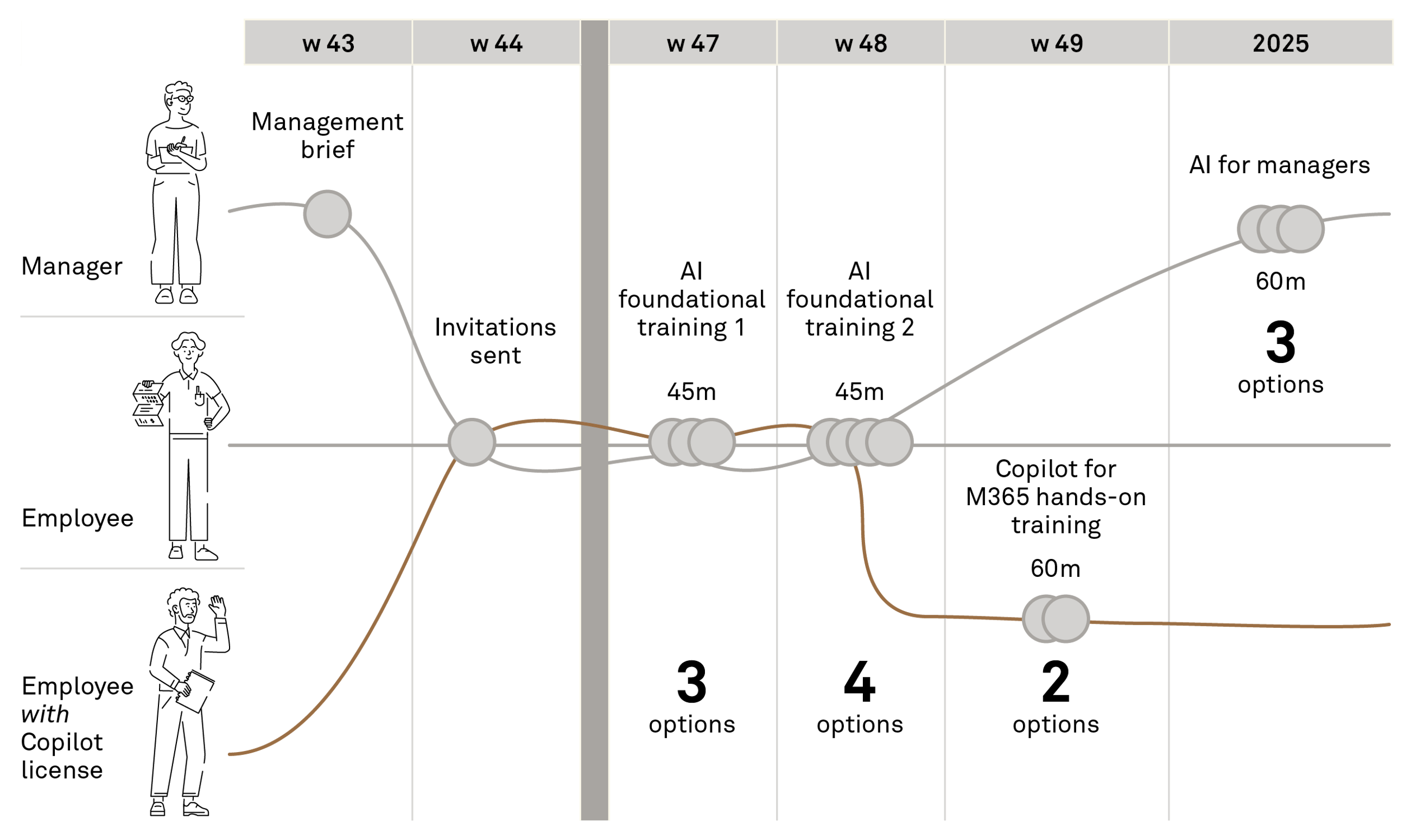Semler Gruppen and Implement Consulting Group
4 February 2025
Semler Gruppen, Denmark’s largest player within the automotive industry, wants to be an AI-driven organisation. Rooted in this strategic ambition, Semler Gruppen is consequently working on bringing AI into its business processes, core systems, and value-adding activities.
On their way towards becoming AI-driven, Semler Gruppen recognised the tremendous value generative AI offers employees in their daily tasks and consequently developed and deployed an in-house version of ChatGPT in 2024. They named it SemlerGPT. The vision was to democratise the use of AI and empower all colleagues throughout the entire business to reap the benefits of AI. In other words, all Semler Gruppen employees should be able to use the available generative AI tools in their work – to increase productivity and the quality of their output.
A project on adopting generative AI
Launching an AI tool is one thing, but getting people to use it is another. Semler Gruppen therefore partnered with Implement to boost the company’s adoption of its generative AI tools, which included Microsoft Copilot and their own SemlerGPT.
The purpose of the project was to expand the use of AI tools in Semler Gruppen to increase productivity and prepare the organisation for a future with even more AI technology.
The generative AI adoption project took place in the autumn of 2024, and the target group was more than 1,600 employees across the entire business.
The specific challenges surrounding this project included:
- Targeting a very diverse group of employees – both geographically and professionally, ranging from academic staff to mechanics.
- Addressing varying levels of IT and generative AI skills across functions – from no skills at all to expertise in the field.
- Working with a large dealer network and many office locations – making broad leadership onboarding and engagement crucial to ensure commitment and the right support for employees.
Based on Semler Gruppen’s situation and their key challenges, we identified three main questions to guide the project and its initiatives.
- How can we design and conduct engaging training that helps all employee groups to reap the benefits of the available generative AI tools, while ensuring it is both scalable post-project and remains relevant?
- How can we create and communicate a compelling story about the use of generative AI in the organisation that encourages colleagues to engage with the new technology?
- How can we increase overall competencies in generative AI – and track the effects of the learning?
Training done right
Guiding question: “How can we design and conduct engaging training that enables all groups of employees to reap the benefits of the available generative AI tools?”
Training is the most common “tool” used in any change project. However, training can take many different shapes and forms based on the circumstances – and it should. In Semler Gruppen’s case, the project team designed the training around the following principles.
The result was three types of trainings:
- Foundational AI training
Two 45-minute online foundational AI training sessions for 1,600 employees at Semler Gruppen. The content covered everything from where to benefit from using generative AI to how to effectively use AI tools in everyday work. - Microsoft Copilot training for all licensed M365 users (100 license holders)
A 60-minute online training session to train and inspire license-holders on how to use the tool across the key Microsoft Office applications, such as PowerPoint, Teams, Word, Excel, and more. - AI for managers
A 60-minute online training session for all managers in Semler Gruppen, where content focused on AI dilemmas, managing AI-powered teams, and driving further AI adoption.
A learning journey beyond training
Guiding question: “How can we create and communicate a compelling story about the use of generative AI in the organisation that encourages colleagues to engage with the new technology?”
A key design criterion for the project was to view “adoption” through a broader lens than just “training”. By considering adoption more broadly, we built a longer and more multifaceted learning journey than is typically seen in traditional adoption projects.
We believe that adoption is driven by generating curiosity, engaging the right advocates, building relevant training content, establishing and measuring adoption, and continuously communicating to stay “visible” within the organisation. And so, our learning journey included communicative components that supported this adoption mindset:
With such a learning journey, the project team made generative AI:
- “a thing in Semler Gruppen”
- “something interesting”
- “something my manager actively supports”
- “something I understand”
- “something I can benefit from “
- “something I use “
- “something I am reminded to use”
The result of heavily investing in communication was that 49% of the survey participants believed that communication had a “large” or “decisive” influence on their attendance and motivation to use AI. 36% believed it had a “little influence,” and 15% rated it as “no influence”. This only goes to show that communication was a sound investment in the adoption project.
Below is an overview of the initiatives deployed:
Driving the adoption of a rapidly evolving technology, such as generative AI, requires aligning it closely with the organisation's context, target group, capabilities, tools, needs, and maturity at that point in time. Learning journeys will, therefore, vary between organisations and should be customised to maximise impact.
Finally, a key observation about learning journeys is that their impact is significantly amplified when backed by a strong mandate. This mandate comes from a solid coalition of stakeholders and sponsors who not only hold the power to put the topic on the agenda but also demonstrate genuine interest and commitment. People listen to those they respect and admire, so identifying these individuals is critical.
At Semler Gruppen, a multilateral steering group with representatives from business, group functions, and IT was established, with the CEO serving as the main sponsor. The importance of this cannot be overstated.
Adoption results
Guiding question: “How can we increase overall competencies in generative AI and track the effects of the learning?”
In many projects and organisations, we experience a lack of adoption KPIs. Measuring impact is important because it holds the project and its stakeholders accountable for working towards a common impact goal.
In this project, an extensive goal hierarchy was established and approved by the steering group to help track and measure impact.
We measured adoption along three dimensions:
- Basic understanding: The target audience possesses a basic understanding of the technology and its applications.
- Usage: The target audience actively uses the available AI tools – such as SemlerGPT and Copilot for Microsoft 365 – in their work.
- Awareness: The target audience is aware of and motivated to engage with Semler Gruppen's AI activities.
Three months of work dedicated to analysis, preparation, execution, and follow-up may not be enough to achieve widespread adoption of generative AI tools. However, three months is the right amount of time to kickstart and build strong momentum for sustained adoption. This was one of the key lesson learned through the training of nearly 1,000 employees.
Without going into details about the multifaceted goal hierarchy, it is worth sharing the following key adoption results:
- 64% of the AI Foundational training participants indicated, after training, that they now recognise several tasks in their daily work where they can use SemlerGPT.
- In six weeks, the total number of active users of SemlerGPT increased by 188%, and the share of active users of M365 Copilot during the training period was 89%.
- 79% of the AI Foundational training participants indicated that they feel motivated to use AI in their daily work after completing the training.
These quantitative measures tell a positive story about the adoption of generative AI at Semler Gruppen. They show that with dedicated resources, a well-designed programme, and a close collaboration between Semler Gruppen and Implement, the project kickstarted the adoption of generative AI and democratised the use of AI. It also raised the overall knowledge of AI across the organisation and increased curiosity towards AI among employees.
Now, what about quality? What are Semler Gruppen colleagues using this technology for? With the increased number of prompts generated by Semler Gruppen employees, the quality of the prompts has significantly improved. They have evolved from simple queries like “Who is the CEO of Semler Gruppen” or “Can you create a picture of a funny cat” to more complex requests such as “Can you help me write a used car sales ad based on this registration number?” This shift demonstrates how generative AI can empower the broader workforce within a very short period – bringing Semler Gruppen one step closer to becoming an AI-driven business.
What do we recommend in a similar project?
- Top management should lead and support the programme to ensure broad engagement in training and strengthen the organisation’s AI capabilities.
- Invest in communication to spark curiosity, engagement, and participation
- Establish a steering group with cross-functional decision-makers who own the benefits of AI adoption.
- Set clear goals and track them using identified metrics, including both short-term goals that indicate project success and long-term goals for future aspirations.
- Use a professional studio to produce high-quality online training, making it more engaging and suitable for distribution into bite-sized training or onboarding material.
- Take a broader approach to adoption than just Copilot for M365. By focusing on increasing generative AI knowledge across the organisation and building curiosity, you can significantly boost the use of available AI tools, including M365 Copilot.








